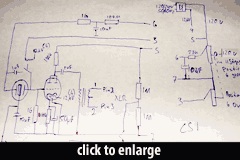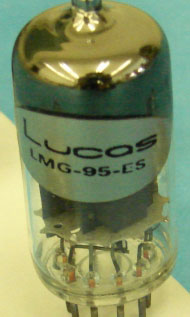 Lucas Engineering CS-1
Lucas Engineering CS-1
Multi-Pattern Tube Condenser Microphone
The Lucas CS-1 is a large-diaphragm tube condenser microphone that was designed as a modern classic, with the intention of answering the question “Why can’t great microphones be made today?” It is the result of a collaboration between Terry Manning (of Compass Point Studios) and Oliver Archut (of TAB-Funkenwerk), which began with Archut’s mod/overhaul of Manning’s disappointing C12VR; the result, says Manning, was “something so far superior that I was shocked by it… it quickly climbed into my Top Mic List.”
The specification process began in conversations between Archut and two design engineers from the original teams that made some of the best-known classic mics — one helped design the Neumann M49/M50 mic and K47/K49 capsule, and the other helped design the AC-701 tube for Telefunken.
 Oliver Archut describes the CS-1 circuit as “simple;” it is not unlike the U-47 amplifier circuit.
Oliver Archut describes the CS-1 circuit as “simple;” it is not unlike the U-47 amplifier circuit.
Oliver Archut
Compared to the U47 [it] is lacking the forced bias at the cathode, and it is arguable that the capacitor across the cathode is introducing phase shift. But [the] capsule, tube and x-former are optimized and that capacitor is just doing the trick keeping everything sane.
The reach what you guys describe is nothing else that the ability of the amp to buffer what is there on the capsule. “
 The tube in the CS-1 was designed and built by Mullard in the UK in the early 1970s. The tube name is LMG-95-ES; this is a Lucas designation of an obscure (if not entirely unknown) Mullard tube that was reportedly designed for use in a high-end audio component. The tube offers low noise and, according to Manning, “a couple of design possibilities that have never before been used in a microphone buffer amplifier:”
The tube in the CS-1 was designed and built by Mullard in the UK in the early 1970s. The tube name is LMG-95-ES; this is a Lucas designation of an obscure (if not entirely unknown) Mullard tube that was reportedly designed for use in a high-end audio component. The tube offers low noise and, according to Manning, “a couple of design possibilities that have never before been used in a microphone buffer amplifier:”
Oliver Archut
To be precise, why not using both sides of the the dual triode to cut impedance in half, what means a lower ratio transformer, and most of all only 1/4 of the noise that a single side would generate. The answer is quite simple, less turn ratio of the x-former that translates in a better resonance tuning of the circuit, less noise, and foremost a higher headroom for the buffer amp. With the selected circuit, any 6072a/12AY7 tube can be utilized in the microphone, but certainly is no match to our CS-1 stock tube.
Terry Manning
That tube is not known by anyone else in the valve world, and will never be made again. We have 7,000 of them, all that were ever made. In our opinion, it is the most robust, and best sounding such tube ever made. It was intended at the time to be the pinnacle of tube manufacture, and as we know, there will likely be no such abilities again. The closest thing to it is the 5 star 6072a, but those spec out at 1 or maybe 2 out of 10 being microphone grade, whereas ours is 6 out of 10.
The capsule is an MBHO unit designed by Herbert Haun’s chief engineer, Manfred Schneider for David Bock’s use in the Soundelux 251 / Bock Audio 251. It is a dual-diaphragm, dual (asymmetrical) backplate, multipattern design modeled to some degree after AKG’s CK-12 capsule.
The circuitry of the CS-1 disables the rear diaphragm in Cardioid mode. (This feature can also be found on the Bock Audio 251.)
The mic’s polar pattern is controlled by an rotary switch on the power supply. It provides 11 discrete patterns from Figure-8 to Omni.
The transformer in the CS-1 was developed by TAB-Funkenwerk specifically for this microphone.
Oliver Archut
The x-former is a newly developed item, fine tuned to the driving tube and foremost the capsule… The basic core is similar to the T14… but with a lower ratio [and] a different winding technique to reduce resonance and overshoot in open loop mode. The base alloy is identical to the V76 but [differently] tempered and stamped here in Gaylord.
 The microphone body is made from tube steel, heat-treated to 1075°F with a proprietary process that results in a scratch-resistant, charcoal-colored finish trademarked as Lucazite®. The process was developed by Jeff Roberts of Latch Lake Music.
The microphone body is made from tube steel, heat-treated to 1075°F with a proprietary process that results in a scratch-resistant, charcoal-colored finish trademarked as Lucazite®. The process was developed by Jeff Roberts of Latch Lake Music.
Jeff Roberts
It’s definitely not powder coat, paint or plating, and far more durable than all of the above finishes. I have now dazzled the principles from 2 different plating firms that had never seen a finish like the CS-1 has…
So what is the Lucazite™ Process? It’s a thermal chemical process that diffuses a layer of nitrogen, carbon, and oxygen into the surface of the steel which forms an epsilon iron nitride layer IN the surface of the steel. The result is a high integrity metallurgical bond not subject to flaking or peeling.
 The CS-1 mics will be hand-built by the TAB-Funkenwerk staff in Gaylord, KS, USA.
The CS-1 mics will be hand-built by the TAB-Funkenwerk staff in Gaylord, KS, USA.
Oliver Archut
The PCBs are made in Gaylord, KS… the mic assembly and PCB is done by my wife; cable and PSU by the lady that makes the V71/78, and I do capsule installment as well as testing.
The CS-1 will not include a shockmount; the inventors claim that no shockmount is necessary in “98%” of cases.
Oliver Archut
For the CS-1 we took up the idea of the M49 with its [internal] shockmount, where the shock-absorber is tuned to the weight of the components, so the [resonant] frequency is below 20Hz. In the CS-1 we went one step further, tube and capsules are shock mounted [separately].
That said, shockmounts that fit the C12VR will fit the CS-1.
The mic will include a swivel mount, designed and manufactured by Latch Lake.
The mic’s name stands for “Condenser Special Number One.”
The prototyping process took about 12 months, beginning with the aforementioned C12VR mod. The first from-scratch CS-1 prototype used the Latch Lake body, MBHO 251 capsule, Mullard tube, and TAB-Funkenwerk T14 transformer. The second prototype incorporated circuitry changes and a revised transformer. The third prototype incorporated additional circuitry changes; it “finally utilized the full extent of Oliver’s design,” according to Manning. This version was engraved with the new Lucas logo and serial number 001. A subsequent update to the transformer changed the output level (+2dB).
The CS-1 warranty is one of the best, and most interesting in the business:
- 5 years “no questions asked” on the electronics
- 1 year on the capsule
- Repairs are free (customer pays all shipping)
- Loaner units will be made available during repairs
The Lucas Engineering CS-1 is also known as: CS1.
The mic was released in 2008.
Specifications
| Pickup Patterns | Pads & Filters |
|---|---|
|
Cardioid
(n/a mV/Pa; n/a) |
|
| Capsule Dimensions | Impedance | SPL/Noise |
|---|---|---|
| Diaphragm diameter: 25mm |
n/a |
| Weight | Length | Max Diameter | Interface(s) |
|---|---|---|---|
| n/a | n/a | n/a |
|
| Power Specifications |
|---|
|
Did we get anything wrong on this page? Please let us know!



